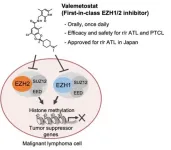Recent developments at MD Anderson offer insights into drug-drug interactions for patients with acute myeloid leukemia (AML) and myelodysplastic syndromes; patient-derived xenograft models as a viable translational research tool in early-phase clinical trials; a novel gene expression signature to stratify patients with bladder cancer; a potential therapeutic target to overcome treatment resistance in multiple myeloma; a role for mutant p53 in protecting against ferroptosis in triple-negative breast cancer; and diet modifications to improve treatment outcomes in FLT3-mutated AML.
IDH1 inhibitor lowers antifungal medication levels in patients with AML and MDS
Patients with IDH1-mutated relapsed/refractory acute myeloid leukemia (AML) usually are treated with the IDH1 inhibitor ivosidenib. However, patients with AML and myelodysplastic syndromes (MDS) are at increased risk of fungal infections and are frequently given triazole antifungal medications, such as posaconazole and voriconazole. To study possible drug-drug interactions, researchers led by Caitlin Rausch, Pharm.D., and Ashley Dinh, Pharm.D., evaluated serum triazole levels in 78 samples from 31 patients receiving ivosidenib-containing therapy in combination with posaconazole and voriconazole. They discovered median triazole levels were significantly reduced during ivosidenib treatment compared to off-treatment samples. Based on the findings, the researchers recommend therapeutic drug monitoring for all patients receiving a triazole antifungal with ivosidenib. They further suggest voriconazole should be avoided, if possible, with empiric high-dose posaconazole as a potential alternative to overcome this drug-drug interaction. Learn more in Cancer.
Co-clinical trial shows potential of PDX models in early-phase clinical trials
Patient derived xenograft (PDX) models – which utilize tissues or cells from patients for in vivo tumor studies – are used to study antitumor activity and mechanisms of intrinsic and acquired resistance, but it is unclear how well they translate to clinical responses. To address this, researchers led by Funda Meric-Bernstam, M.D., developed PDX models in a co-clinical trial to compare against patient responses with the bispecific HER-2 targeted antibody zanidatamab. Of 36 tumors implanted, the researchers established 19 models from 17 patients with a broad range of HER2-expressing cancers. In vivo testing showed the PDXs accurately reflected the tumor characteristics and antitumor activity of their matched patients in seven of eight co-clinical models. Additionally, the researchers identified amplification of MET and MYC genes as a potential mechanism of zanidatamab resistance, showing that MET inhibitors enhanced zanidatamab both in vitro and in vivo. This study provides evidence that PDXs established from biopsies in clinical trials are a powerful translational research tool, providing further insights for developing therapeutic strategies. Learn more in Cancer Discovery.
Study identifies potential therapeutic target for subset of patients with bladder cancer
Many patients with metastatic bladder cancer have inactivated SMARCB1, which is normally involved in DNA remodeling. The loss of SMARCB1 activates the STAT3 inflammation pathway and is a well-known biomarker of aggressive renal medullary carcinoma, suggesting that these events drive tumor growth and progression. To provide further insights, researchers led by Pavlos Msaouel, M.D., Ph.D., used lab models of bladder cancer without SMARCB1. SMARCB1 deficiency led to increased STAT3 activation as well as increased tumor growth and metastasis. The researchers saw increased STAT3 activation in patients with bladder cancer and showed that treatment with a STAT3 inhibitor reduced tumor growth and metastasis in vivo, highlighting its therapeutic potential. The team also developed a novel gene expression signature to help identify SMARCB1-deficient patients most likely to benefit from STAT3 inhibitors, and they suggest it merits further clinical evaluation in this subset of patients. Learn more in Nature Communications.
Scientists discover potential therapeutic target to overcome treatment resistance in multiple myeloma
Patients with multiple myeloma, a type of blood cancer that affects the bone marrow, can develop resistance to treatments that induce DNA damage. These treatments target interleukin enhancer binding factor 2 (ILF2), a key regulator of the DNA damage response. ILF2 is overexpressed in 70% of patients with multiple myeloma who develop treatment resistance, leading Simona Colla, Ph.D., and colleagues to further examine this pathway. They showed that cancer cells rewire their metabolism in response to DNA damage. The researchers then used CRISPR/Cas screening to identify the mitochondrial DNA repair protein DNA2 as the main driver of cancer cell survival following treatment. These preclinical results highlight DNA2 as a potential therapeutic target meriting further evaluation for overcoming treatment resistance in patients with multiple myeloma and possibly other cancers. Learn more in Nature Communications.
Mutant p53 protects against ferroptosis in triple-negative breast cancer
The TP53 tumor suppressor gene, often mutated in cancer, is an early mutation in most patients with triple-negative breast cancer (TNBC). The exact role of mutant p53 in tumor maintenance is unknown, as studies typically either express mutant p53 in all cells or remove mutant p53 in both tumor cells and the tumor microenvironment. To provide further molecular insights, researchers led by Guillermina “Gigi” Lozano, Ph.D., generated TNBC models with mutations at two specific hotspots in the TP53 gene. They engineered these models so that mutant TP53 expression could be turned on or off specifically in tumor cells, maintaining wild-type p53 in the tumor microenvironment. Turning off these hotspots triggered ferroptosis – a type of cell death dependent on iron – in vivo. Using single-cell transcriptomics, the researchers uncovered two enzymes through which mutant p53 protects against ferroptosis, highlighting specific potential targets meriting further evaluation for these patients. Learn more in Science Advances.
Diet modifications improve treatment response in models of FLT3-mutated AML
Patients with FLT3-mutated acute myeloid leukemia (AML) usually have a poor prognosis, underscoring a need to improve treatment outcomes. Studies have shown that a poor diet can lead to more aggressive tumors in other cancers, but none have examined if healthy diets can improve outcomes in FLT3-mutant AML. Researchers led by Joya Chandra, Ph.D., examined the impact of diet modification in preclinical models of FLT3-mutated AML treated with anthracycline. The treatment was more effective with a low-fat and/or low-sugar diet. Time-restricted feeding (TRF) within a 12-hour window also slowed leukemia growth compared to unrestricted access to food. Additionally, TRF and a low-sugar diet increased the expression of circadian protein BMAL1, which induced cell death. These accessible behavioral modifications slowed progression of FLT3-mutated AML growth in vivo, meriting further evaluation for this patient population. The study highlights BMAL1 as a potential therapeutic target and underscores the importance of considering diet modifications as potential options to improve treatment outcomes. Learn more in Cancer Medicine.
Awards and honors
Valerae Lewis, M.D., chair of Orthopaedic Oncology, was appointed chair of the American Academy of Orthopaedic Surgeons’ (AAOS) Membership Council. In case you missed it
Read below to catch up on recent MD Anderson press releases.
Immunotherapy before surgery leads to promising long-term survival in sarcoma patients Biomarker-directed combination effective in immunotherapy-resistant lung cancer MD Anderson and C-Biomex sign collaborative research agreement to co-develop CBT-001 radioligand therapy in the MD Anderson Newsroom.
- 30 -
END


